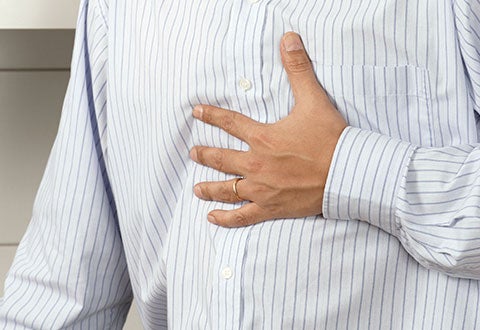If you are experiencing a sensation of discomfort, tightness or pressure in your chest, take heed.
While a chest discomfort may simply be due to stress or indigestion, a recurring chest pain which is often provoked by exertion or stress, also known as angina, could be linked to coronary artery disease. Angina that lasts longer than 15 minutes and not relieved by rest might signal an impending heart attack.
A
heart attack occurs when there is a sudden obstruction of blood flow in the coronary artery. The part of the heart muscle which does not receive blood would be at risk of injury, also known as myocardial infarction (MI). In such instances, emergency treatment is required. This involves blood-thinning medication and coronary angioplasty (e.g. ballooning or stenting) to quickly unblock the affected coronary artery, allowing blood to flow. In some cases, coronary artery bypass surgery (CABG) may be required.
Sudden cardiac arrest is different from a heart attack. Cardiac arrest occurs when there is a dangerous form of electrical malfunction in the heart, known as lifethreatening arrhythmia. This causes the patient’s heart to pump ineffectively, resulting in the inability of vital organs to receive blood and oxygen. If the patient does not receive emergency treatment, death usually ensues within minutes. However, with immediate cardiopulmonary resuscitation (CPR) and treatment with automated external defibrillator (AED), the patient may recover with restoration of normal heart rhythm.

Coronary arteries that supply the heart with oxygenated blood can slowly narrow due to a build-up of plaque leading to angina. In a heart attack, there is sudden plaque rupture leading to blood clot formation, blocking the artery.
HEART ATTACK VS CARDIAC ARREST
Heart Attack |
Cardiac Arrest |
| Symptoms
A heart attack can trigger life-threatening arrhythmia, leading to sudden cardiac arrest. The symptoms of a heart attack are typically more pronounced. They include:
- Sudden onset of severe chest pain or discomfort lasting longer than 15 minutes
- Sudden onset of shortness of breath, with or without chest pain
- New onset of chest pain or discomfort at rest or with minimal exertion
- Cold sweat, nausea or lightheadedness typically associated with chest pain/discomfort or shortness of breath
| Symptoms
Sudden cardiac arrest often occurs without warning symptoms. A person with sudden cardiac arrest might lose consciousness, collapse suddenly and become pulseless. Dr Lee Phong Teck, Associate Consultant, Department of Cardiology, says that occasionally, shortlived warning symptoms might occur, which include: - Chest pain
- Heart palpitations
- Shortness of breath
- Light-headedness
|
| Who's at risk?
Certain risk factors increase the probability of developing a heart attack. These include: - Smoking
- High blood pressure (hypertension)
- Diabetes mellitus
- High cholesterol (hyperlipidaemia)
- Family history of heart disease or stroke (male first-degree relatives aged below 55, or female first-degree relatives aged below 65)
- Overweight, physical inactivity and a diet high in saturated fats
|
Who's at risk?
“Cardiac arrest usually develops in a person with pre-existing, possibly undiagnosed heart condition,” shared Dr Lee. These conditions include: - Coronary artery disease, including a heart attack
- Heart failure, especially when the left ventricular ejection fraction is less than 30-35%
- Significant valvular heart disease
- Complex congenital heart disease
- Inherited arrhythmias
|
This article is from Murmurs Issue 33 (Jan – Apr 2019). Click
here to read the full issue.















 Get it on Google Play
Get it on Google Play